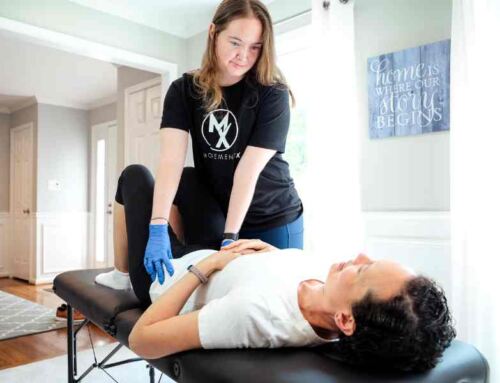From Surviving to Thriving: How Physical Therapy Helps Breast Cancer Survivors
“I should be thankful. I survived cancer.”
That’s what my patient, Jenny, told me. She had just completed months of chemotherapy and radiation and had undergone a total mastectomy. Though she was declared “cancer-free,” Jenny was far from feeling like herself again. As a mother of three, a teacher, and a former triathlete, she was struggling to keep up with her children, hesitant about returning to work, and couldn’t imagine training for a triathlon again. Some days, even getting out of bed felt overwhelming.
Her oncologist recommended she see a physical therapist to help her regain her strength and confidence. Jenny was hesitant at first. After all, shouldn’t she just be grateful to have survived? “It’s okay to be thankful for survival and want to return to your old self,” I reassured her. “It’s great you survived. Now, let’s help you thrive.”
Breast Cancer Survivorship: The Challenges Don’t End After Treatment
Breast cancer is the second most common cancer in women, accounting for 30% of new cancer diagnoses. With advancements in screening and treatment, the survival rate for breast cancer has risen to 97.5%. This means that most women diagnosed with breast cancer will survive, but survival doesn’t mean the journey is over.
In 2024, it was estimated that over 4 million breast cancer survivors live in the U.S. alone. While these statistics are promising, many survivors face long-term physical and emotional challenges that can significantly impact their quality of life. These include:
- Lymphedema: Swelling in the arm or breast from lymph node removal or damage.
- Cancer-related fatigue: Persistent exhaustion that limits daily activities.
- Post-surgical pain and mobility issues: Pain and stiffness in the chest, shoulders, and arms from surgery and radiation.
- Peripheral neuropathy: Numbness, tingling, and pain caused by nerve damage from chemotherapy.
- Deconditioning: Loss of endurance, strength, and cardiovascular health.
Unfortunately, many survivors are told to live with these side effects, believing that they are just part of the new normal. But this isn’t true. With the right resources, breast cancer survivors can manage these complications and regain control of their lives.

The Benefits of Exercise for Breast Cancer Survivors
One intervention proven to reduce long-term complications and even improve survival is exercise. Studies show that physical activity is not only protective against breast cancer recurrence but also enhances overall survival. Regular exercise has a profound impact on:
- Reducing the risk of cancer recurrence
- Improving heart health, especially after chemotherapy and radiation, which can damage the heart.
- Increasing physical function, reducing frailty, and lowering the risk of other chronic diseases.
Despite these benefits, research shows that breast cancer survivors often decrease their physical activity over time, particularly after completing treatment. This decline in activity can lead to increased frailty, cardiovascular disease, and decreased quality of life. This is where physical therapists play a critical role.
How Physical Therapy Can Help Breast Cancer Survivors
Physical therapists are uniquely qualified to help breast cancer survivors manage long-term side effects from treatment and safely reintroduce exercise into their routine. A personalized, evidence-based approach ensures that each survivor’s recovery plan is tailored to their specific needs and goals.
Here’s how physical therapy can address common side effects of breast cancer treatment:
- Lymphedema Management: Specialized techniques like manual lymph drainage, therapeutic exercises, and compression bandaging can reduce swelling and improve mobility.
- Cancer-Related Fatigue: Tailored aerobic and strength-training programs can significantly reduce fatigue, boost energy, and improve the ability to return to daily activities.
- Post-Surgical Pain and Mobility: Through manual therapy, stretching, and mobility exercises, physical therapists can improve range of motion, reduce scar tissue restrictions, and alleviate pain in the chest, shoulders, and arms.
- Peripheral Neuropathy: Nerve damage from chemotherapy can cause pain and numbness in the hands and feet. Physical therapy can help restore nerve function and improve balance and coordination.
- Deconditioning: A personalized exercise program, designed by a physical therapist, can help rebuild endurance, strength, and cardiovascular health, allowing survivors to regain confidence in their physical abilities.
MovementX: Your Partner in Recovery
At MovementX, we understand the unique challenges breast cancer survivors face. Our one-on-one approach ensures personalized care, where your therapist works closely with you to create a plan that addresses your individual needs—whether it’s lymphedema, fatigue, or simply feeling like yourself again. We bring our services directly to your home, office, or gym, making recovery as convenient and comfortable as possible.
Ready to Take the Next Step Toward Thriving?
Don’t settle for just surviving—reclaim your strength, energy, and confidence with the help of a physical therapist. If you’re a breast cancer survivor or currently undergoing treatment, MovementX is here to support you every step of the way. Our expert therapists are ready to create a customized recovery plan that helps you regain control of your life.
Contact us today and start your journey toward thriving after breast cancer.








